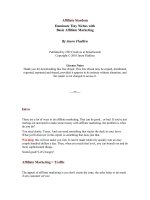BASIC MARKETING
Bạn đang xem bản rút gọn của tài liệu. Xem và tải ngay bản đầy đủ của tài liệu tại đây (3.18 MB, 127 trang )
Marketing ManagementMarketing Management
Prepared by : Soft Skills Unit Prepared by : Soft Skills Unit
Course OutlineCourse Outline
Lecture 1 : Marketing Principles
Lecture 2 : Market Segmentation and Target Markets
Lecture 3 : Consumer Buying Behavior and Decision MakingLecture 3 : Consumer Buying Behavior and Decision Making
Lecture 4 : Marketing plan
Lecture 1 ContentLecture 1 Content
• Definitions
• Concepts
• Difference between Marketing & Selling
• The Marketing Environment
• The Marketing Mix
• The Marketing Strategies
1. Marketing Principles
A. Definitions
- Marketing deals with identifying & meeting human & social needs
- Marketing is a societal process by which individuals and groups obtain what they
need through creating , offering and freely exchanging products and services
of value with others.
-Marketing is the process by which companies create value for customers &
build strong customer relationships in order to capture from customers in return.
B. Concepts
1. Customer Needs, Wants and Demands
2. Exchange and Transactions 2. Exchange and Transactions
3. Markets
B .1. Customer Needs, Wants and Demands
Needs: are the basic human requirements; as food, air, water..etc
Wants: when they are directed to specific objects that might satisfy the need
Ex: want to eat Hamburger
Demands: are wants for specific products backed by an ability to pay.
B .2. Exchange and Transactions
Exchange : is the core concept of marketing; is the process of obtaining a
desired product from someone by offering something in return.
-Exchange is a value creating process because it normally leaves both parties
better off.
Transaction : is a trade of values between 2 or more parties
- When an agreement is reached , we say transaction takes place.
B. 3. Markets
Suppliers
Company
Marketing
Intermediaries
Final
Users
Suppliers
Competitors
Intermediaries
Users
Marketing System
The Market word has many definitions :
• A place where buyers and sellers meet, good and services are offered
for sale and transfers for ownership occurs.for sale and transfers for ownership occurs.
• People or organizations with wants to satisfy, money to spend and the
willingness to spend.
C. Difference between Marketing & Selling
Factory Existing
Selling & Profits thru
Selling Concept
Starting Point
Focus Means Ends
Factory Existing
Products
Selling &
Promoting
Profits thru
sales volume
Market Customer
Needs
Integrated
Marketing
Profits thru
Customer
satisfaction
Selling Concept
Marketing Concept
*
D. The Marketing Environment
-The actors and forces outside marketing that affect marketing management ability to
build and maintain successful relationships with target customers.
- It is made up of microenvironment and macroenvironment.
Macro Environment
Political
Factors
Economic
Factors
Natural
Factors
Technological
Factors
Micro Environment
Customers
Suppliers
Competitors
Internal
Environment
1. Microenvironment
1. Customers :
- Consumer Markets ; consists of individuals & households
- Business Markets; buy goods & services for further processing
- Reseller Markets; buy goods & services to resell at a profit
- Government Markets; government agencies that buy goods & services to
produce public services
- International Markets; consists of buyers in other countries as consumers;
producers; resellers….etc
2. Competitors
3. Suppliers; supply problems that affect the marketing can be supply shortage,
or delays, labor strikes , supply costs …etc
2. Macro environment
1. Economic Factors: factors that affect consumer buying power &
spending patterns as:
• Changes in Income
• Changing customer spending patterns
• Unemployment
• Inflation
2. Political / Legal Factors: organizations are
affected by :
• Governmental regulations & rules
• Tax regime
• Trade policies• Trade policies
• Special interests
3. Technological Factors: forces that create new technologies,
creating new products and opportunities
• Examples antibiotics; laptops, robotic surgery ..etc
4. Natural Factors : involves the natural resources needed as inputs
by marketers and may affect marketing activities; as :
• Shortage of raw materials
• Increased pollution
• Energy Sources
E. The Marketing Mix
Marketing
Mix
Product
Place
• Product Variety
• Channels
Locations
Price
Promotion
• Product Variety
• Quality
• Design
• Brand name
• Packaging
• Services
• Warranties
• List Price
• Discounts
• Allowances
• Payment period
• Credit Terms
• Sales Promotion
• Advertising
• Public Relations
• Personal Selling
• Direct Marketing
• Locations
• Inventory
• Transport
E.1 Product
Products include physical objects, services, events, persons, places, ideas…etc
1. Consumer Products
2. Industrial Products
*
Product Life CycleProduct Life Cycle
*
Three Levels Of ProductThree Levels Of Product
Augmented Product
Actual Product
Brand
After
Sale
service
Features
Delivery
Core
Benefit
Brand
name
Quality
level
service
Features
Design
Packaging
Warranty
&
Credit
Installation
E.2 Place
• Refers to how an organization will distribute the product or service they are offering to the
end user.
• The organization must distribute the product to the user at the right place at the right time.
• Two types of channel of distribution methods are available;
E.3 Price
It is the amount of money charged for a product or service, it is agreed upon
that the price offered must cover the cost of the product and return a profit to
the producer .
There are 5 marketing objectives to determine the price of a product :
a. Maximize short term profit
b. Maximize current market share
c. Market skimming
d. Product quality leadership
e. Survival
Cont’d
a. Maximize short term profit
Understanding the market dynamics, will assist the company in making good
predictions as to how the customers will react to a particular price.
b. Maximize current market share
Sometimes called Market Penetration Pricing; co. sets out to price their product Sometimes called Market Penetration Pricing; co. sets out to price their product
such as to capture the highest amount of market share.
c. Survival
Companies employing this strategy, set the price above the cost of production,
ensuring the firm will remain operational.
E.4 Promotion
There are 5 different key types of promotion :
1. Advertising
2. Sales Promotion
3. Public Relations
4. Personal Selling
5. Direct Marketing
Cont’d
1. Advertising
• Popular means of reaching a target audience.
• Cost effective way to build awareness.
• To create a good ad, the marketer must create a message that is distinct,
meaningful and credible.meaningful and credible.
• There are many advertising 'media' such as newspapers, magazines and journals,
television, cinema, outdoor advertising (such as posters, bus sides).
Cont’d
*









